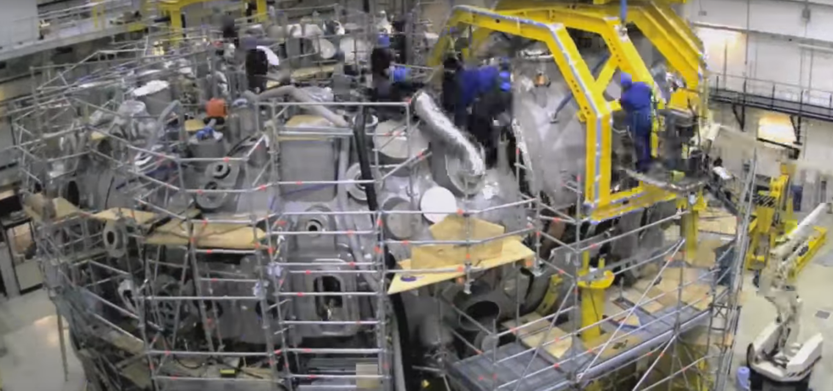Fusion Power
Angela Merkel switched on the first hydrogen plasma reactor at Germany's Wendelstein 7-X experiment, marking the start of scientific operation of the project. The objective of fusion research is to develop a power plant that derives energy from the fusion of atomic nuclei just as the sun and the stars do.
"With a temperature of 80 million degrees and a lifetime of a quarter of a second, the device’s first hydrogen plasma has completely lived up to our expectations."
This marks the start of scientific operation. Wendelstein 7-X, the world’s largest fusion device of the stellarator type, is to investigate this configuration’s suitability for use in a power plant.
Since the start of operation in December last year, Wendelstein 7-X has produced more than 300 discharges with the rare gas, helium. These served primarily to clean the plasma vessel. The cleaner the vessel wall, the more the plasma temperature increased, finally attaining six million degrees.
In addition, plasma heating and data recording were tested, and the first measuring facilities for investigating the plasma were put into operation. This included complex instrumentation such as X-ray spectrometers, interferometers, laser scattering and video diagnostics.
“This makes everything ready for the next step”, states Project Head Professor Dr. Thomas Klinger. “We are changing from helium to hydrogen plasmas, our proper subject of investigation.”
The first hydrogen plasma, which was switched on at a ceremony attended by numerous guests from the realms of science and politics, marks the start of scientific operation of Wendelstein 7-X. At the push of a button by Federal Chancellor Angela Merkel, a 2-megawatt pulse of microwave heating transformed a tiny quantity of hydrogen gas into an extremely hot low-density hydrogen plasma. (see video below, queued to Merkel's big moment).
This procedure involves separation of the electrons from the nuclei of the hydrogen atoms. Confined in the magnetic cage generated by Wendelstein 7-X, the charged particles levitate without making contact with the walls of the plasma chamber. “With a temperature of 80 million degrees and a lifetime of a quarter of a second, the device’s first hydrogen plasma has completely lived up to our expectations”, states Dr. Hans-Stephan Bosch, whose division is responsible for operation of Wendelstein 7-X.
The objective of fusion research is to develop a power plant favourable to the climate and environment that derives energy from the fusion of atomic nuclei just as the sun and the stars do.
As the fusion fire only ignites at temperatures of more than 100 million degrees, the fuel – a thin hydrogen plasma – must not come into contact with cold vessel walls. Confined by magnetic fields, it floats virtually free from contact within the interior of a vacuum chamber. For the magnetic cage, two different designs have prevailed – the tokamak and the stellarator. Both types of system are being investigated at the IPP. In Garching, the Tokamak ASDEX Upgrade is in operation, the Wendelstein 7-X stellarator is operating in Greifswald
Since the start of operation in December last year, Wendelstein 7-X has produced more than 300 discharges with the rare gas, helium. These served primarily to clean the plasma vessel. The cleaner the vessel wall, the more the plasma temperature increased, finally attaining six million degrees.
In addition, plasma heating and data recording were tested, and the first measuring facilities for investigating the plasma were put into operation. This included complex instrumentation such as X-ray spectrometers, interferometers, laser scattering and video diagnostics.
“This makes everything ready for the next step”, states Project Head Professor Dr. Thomas Klinger. “We are changing from helium to hydrogen plasmas, our proper subject of investigation.”
This procedure involves separation of the electrons from the nuclei of the hydrogen atoms. Confined in the magnetic cage generated by Wendelstein 7-X, the charged particles levitate without making contact with the walls of the plasma chamber. “With a temperature of 80 million degrees and a lifetime of a quarter of a second, the device’s first hydrogen plasma has completely lived up to our expectations”, states Dr. Hans-Stephan Bosch, whose division is responsible for operation of Wendelstein 7-X.
Related articles
The present initial experimentation phase will last till mid-March. The plasma vessel will then be opened in order to install carbon tiles for protecting the vessel walls and a so-called “divertor” for removing impurities. “These facilities will enable us to attain higher heating powers, higher temperatures, and longer discharges lasting up to ten seconds”, explains Professor Klinger. Successive extensions are planned until, in about four years, discharges lasting 30 minutes can be produced and it can be checked at the full heating power of 20 megawatts whether Wendelstein 7-X will achieve its optimization targets.The objective of fusion research is to develop a power plant favourable to the climate and environment that derives energy from the fusion of atomic nuclei just as the sun and the stars do.
As the fusion fire only ignites at temperatures of more than 100 million degrees, the fuel – a thin hydrogen plasma – must not come into contact with cold vessel walls. Confined by magnetic fields, it floats virtually free from contact within the interior of a vacuum chamber. For the magnetic cage, two different designs have prevailed – the tokamak and the stellarator. Both types of system are being investigated at the IPP. In Garching, the Tokamak ASDEX Upgrade is in operation, the Wendelstein 7-X stellarator is operating in Greifswald






0 comments:
Post a Comment